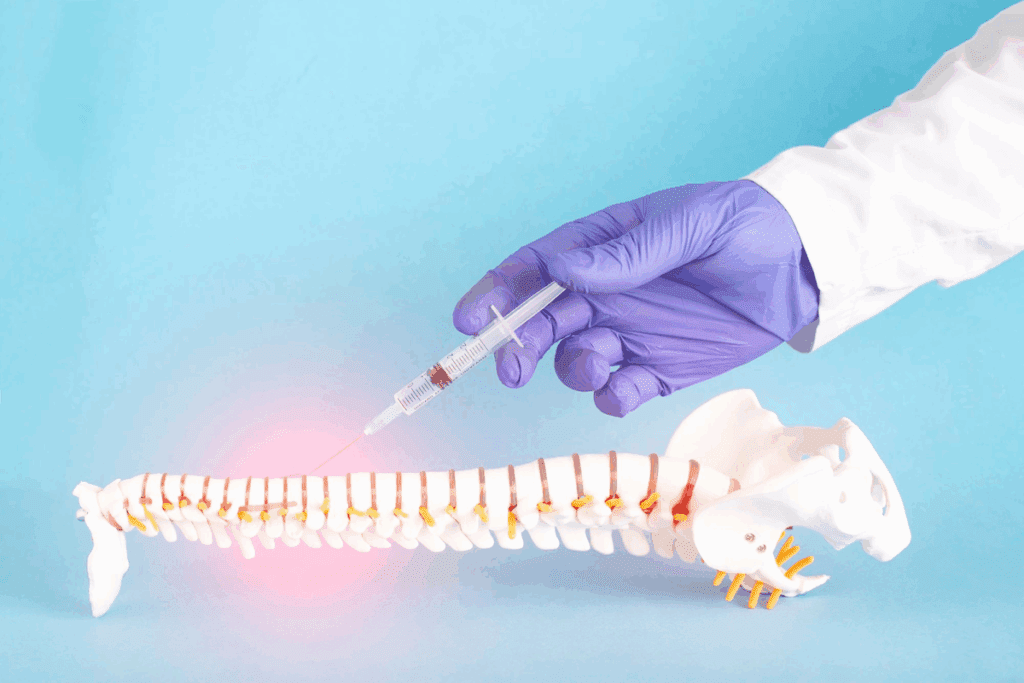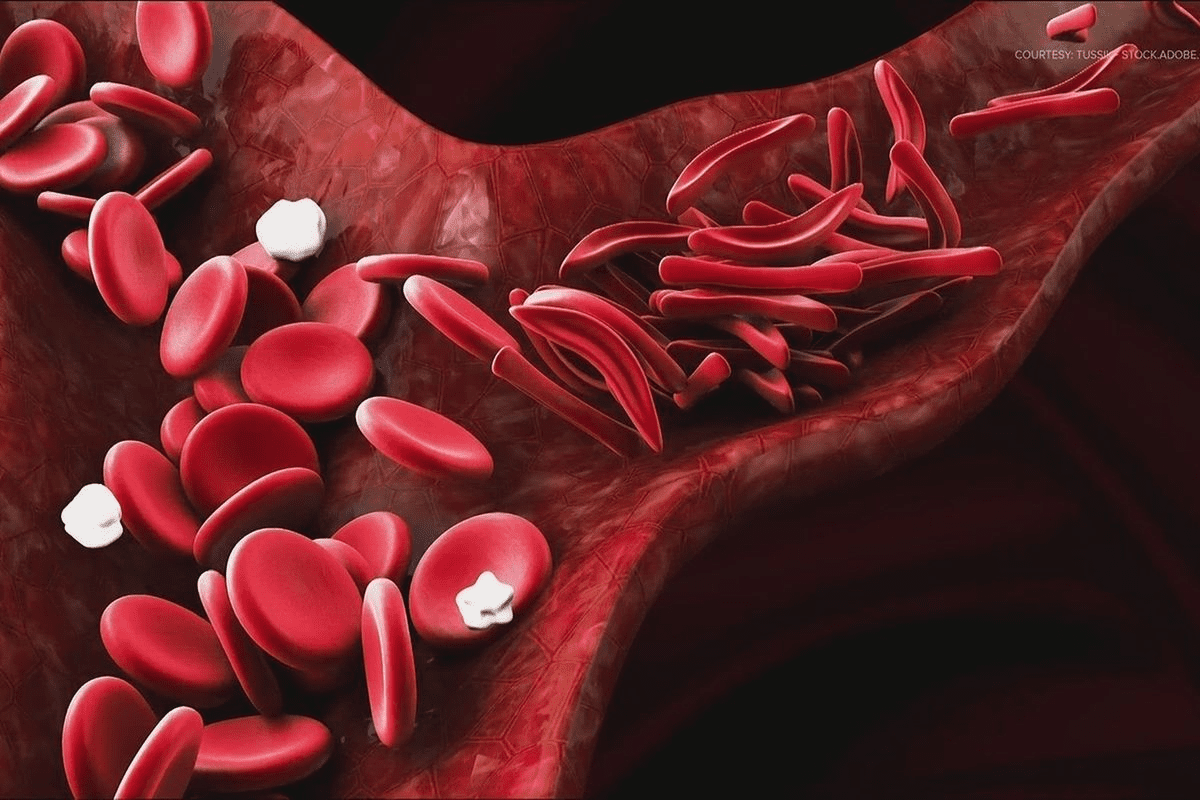Last Updated on November 26, 2025 by Bilal Hasdemir

Lumbar facet injections are minimally invasive, image‑guided treatments that place anesthetic and anti‑inflammatory medication at the facet joints to diagnose and relieve facet‑related pain, helping restore motion and support rehab; most patients tolerate “facet injections in lower back” well and resume light activity within a day.
Key Takeaways
- Minimally invasive procedure for targeted pain relief
- Advanced technology ensures accurate delivery of medication
- Personalized care from experienced medical professionals
- Effective treatment for chronic lower back pain
- Quick recovery time and reduced risk of complications
Understanding Lumbar Facet Joint Pain

The lumbar facet joints are key to our spinal health. They are small joints between and behind the vertebrae. They help our spine move and stay stable.
Anatomy of Facet Joints in the Spine
Facet joints have a special lining that helps them move smoothly. The lumbar facet joints are important because they help carry the spine’s weight. They are vital for a healthy back.
Common Causes of Facet Joint Dysfunction
Facet joint problems can come from many sources. Arthritis can cause the joints to hurt by causing inflammation. Trauma, like from a car accident, can also harm them. Plus, doing the same thing over and over or not standing up straight can cause issues.
As we get older, our facet joints can wear down. This can make our backs hurt and stiff. Being overweight or not moving much can make this worse. Knowing why it happens helps doctors find better ways to treat it.
Symptoms of Lumbar Facet Joint Problems
Problems with the lumbar facet joints can cause pain and stiffness in the lower back. This pain might spread to the buttocks or thighs, but usually doesn’t go past the knee. People might also find it harder to move and feel stiff, mostly after sitting or lying down for a while.
“Facet joint pain can significantly impact a person’s quality of life, making everyday activities challenging.”
It’s important to know these symptoms to get help. Doctors can figure out if you have a problem with your facet joints by looking at you, asking about your health, and using imaging tests.
What Are Facet Injections in the Lower Back?

Facet injections are a solution for lower back pain caused by facet joint issues. They involve injecting a mix of anesthetic and anti-inflammatory medication into or around the facet joint. This method is used for both diagnosis and treatment of lumbar facet joint pain.
Definition and Purpose
Facet injections are a procedure where medications are given directly to the facet joints. These joints are small and located between and behind the vertebrae. The main goal is to lessen pain and swelling in these joints.
By doing this, facet injections can greatly improve the lives of those with chronic lower back pain. We use a mix of local anesthetics and corticosteroids in these injections. Local anesthetics provide quick pain relief to help find the pain source. Corticosteroids then reduce inflammation and offer longer-lasting pain relief.
Types of Medications Used
The medications in facet injections include:
- Local Anesthetics: Such as lidocaine or bupivacaine, which numb the area and provide immediate pain relief.
- Corticosteroids: Like triamcinolone or betamethasone, which are strong anti-inflammatory agents.
The choice of medication depends on the patient’s condition and the doctor’s preference. This mix helps in diagnosing and treating the pain effectively.
Diagnostic vs. Therapeutic Applications
Facet injections have both diagnostic and therapeutic uses. They help find out if the facet joint is causing the pain. If the patient feels pain relief after the injection, it confirms that the facet joint is the pain source.
Therapeutically, facet injections reduce inflammation in the facet joints. While the relief might not last long, repeated injections can offer long-term benefits for some patients.
| Application | Purpose | Benefits |
| Diagnostic | Identify the source of pain | Helps in confirming if the facet joint is the pain generator |
| Therapeutic | Provide pain relief | Reduces inflammation, offers temporary to sustained pain relief |
“The use of facet injections has revolutionized the management of chronic lower back pain, providing a minimally invasive alternative to more invasive surgical procedures.”
— Expert in Pain Management
Understanding facet injections’ role in diagnosis and treatment helps patients make informed decisions. It’s important to talk to a healthcare professional to see if facet injections are right for you.
The Complete Facet Injection Procedure
The facet injection procedure is a precise method to treat lower back pain from facet joints. It includes several steps from preparation to the actual injection. This ensures patients get targeted pain relief.
Pre-Procedure Preparation
Before a facet injection, patients get a detailed check to see if their pain is from the facet joints. This might include a physical exam, looking at imaging studies, and sometimes diagnostic injections.
We also ask patients about their medications, like blood thinners. And we tell them to bring someone to drive them home after the procedure.
Step-by-Step Procedure Walkthrough
The procedure is done with the patient lying on their stomach on an X-ray table. We start by cleaning and numbing the skin where the needle will go.
We use fluoroscopy, a real-time X-ray, to guide the needle into the facet joint. After the needle is in place, we inject a contrast dye to check the placement. Then, we inject medication into the joint.
The Critical Role of Fluoroscopy Guidance
Fluoroscopy is key for accurate facet injections. It gives us real-time images to guide the needle into the facet joint. This ensures the medication goes exactly where it’s needed.
This makes the treatment more effective and reduces the risk of complications.
To show the facet injection steps and results, here’s a summary:
| Procedure Step | Description | Importance |
| Pre-procedure evaluation | Confirm facet joint pain and review patient history | Ensures appropriate candidates for the procedure |
| Needle placement | Guided by fluoroscopy into the facet joint | Accuracy in delivering medication |
| Medication injection | Contrast dye followed by therapeutic medication | Diagnostic and therapeutic benefits |
Knowing the facet injection procedure helps patients prepare for treatment and recovery.
7 Key Benefits of Lumbar Facet Joint Injections
For those with lumbar facet joint pain, injections can bring relief and a better quality. Lumbar facet joint injections are a key treatment for chronic lower back pain. We’ll look at the main benefits of this procedure, showing how it helps with facet joint issues.
Targeted Pain Relief at the Source
One big plus of lumbar facet joint injections is targeted pain relief. The medication goes right into the painful facet joint. This can greatly reduce or stop the pain in that area.
Reduced Inflammation in Affected Joints
These injections often include anti-inflammatory meds like corticosteroids. They help reduce inflammation in the joints. This is key to easing pain and improving joint function.
Improved Mobility and Function
By tackling pain and inflammation, lumbar facet joint injections can boost mobility and function. People often find it easier to do daily tasks and even join in physical activities they couldn’t before.
Enhanced Physical Therapy Participation
With less pain and better mobility, patients can do more in physical therapy. This is vital for long-term recovery and better spinal health.
To better understand the benefits of lumbar facet joint injections, let’s look at a comparison table:
| Benefit | Description | Impact on Patient |
| Targeted Pain Relief | Direct injection into the affected facet joint | Significant reduction in pain |
| Reduced Inflammation | Anti-inflammatory medication | Improved joint function |
| Improved Mobility | Reduced pain and inflammation | Enhanced ability to perform daily activities |
| Enhanced Physical Therapy | Better tolerance for exercises | Improved long-term recovery and spinal health |
The table shows how lumbar facet joint injections tackle chronic lower back pain in many ways. They offer targeted relief, reduce inflammation, improve mobility, and help with physical therapy. These benefits can greatly enhance a patient’s quality of life.
Common Sites for Facet Block Back Pain Treatment
Finding the right spot for facet block back pain treatment is key. Facet injections target pain in the lower back. Some spots are more common than others for this treatment.
L4-L5 Facet Joint Injections
The L4-L5 area is often treated with facet injections. It’s prone to strain and wear because of its location and stress. L4-L5 facet joint injections help with pain from this spot. The treatment involves injecting medicine into the joint to reduce inflammation and pain.
Other Frequent Injection Locations
While L4-L5 is common, injections can also be given at L3-L4 and L5-S1. The choice depends on the patient’s condition and pain. Spinal facet injections are customized to meet each patient’s needs, making treatment more effective.
Tailoring Treatment to Specific Pain Patterns
Success in facet block treatment comes from accurately finding the pain source. We use tests and patient history to pick the best spots. By focusing on the right facet joints, we offer better relief and improve life quality.
What to Expect Before, During, and After Your Facet Injections
Learning about facet injections in the lower back can ease your worries. We help our patients understand every step of the process. This makes sure you’re comfortable and clear about what’s happening.
Pre-Procedure Preparations and Restrictions
Before your facet injection lumbar procedure, we’ll give you specific instructions. This might include:
- Stopping certain medications that could interfere with the procedure or your recovery
- Avoiding food and drink for a specified period before the treatment
- Arranging for someone to drive you home after the procedure
Telling us about any allergies, medical conditions, or medications you’re taking is also key. This helps us make the treatment fit your needs and reduce risks.
The Patient Experience During the Procedure
During the facet injections lower back procedure, you’ll be placed comfortably on an X-ray table. We’ll use fluoroscopy, a type of X-ray imaging, to guide the injection accurately into the affected facet joint. The procedure typically involves:
- Cleaning and numbing the injection site
- Inserting a needle into the facet joint under fluoroscopic guidance
- Administering a combination of a local anesthetic and a corticosteroid
Most patients feel only a little discomfort during the procedure. It usually takes about 15 to 30 minutes.
Immediate Post-Procedure Effects
After the lumbar facet block procedure, you might feel some immediate effects, including:
- Numbness or a tingling sensation due to the local anesthetic
- Soreness at the injection site
- Potential temporary increase or decrease in pain
These effects are usually short-lived and should go away within a few hours. We’ll give you instructions on how to manage any discomfort and ensure a smooth recovery.
Recovery Timeline and Follow-Up Care
The recovery time for facet injections lower back varies, but most people can get back to normal in a day or two. We’ll schedule a follow-up appointment to check how the treatment is working. We’ll also discuss further options for managing your condition.
It’s important to keep track of your pain levels and any changes in your symptoms after the procedure. This helps us tailor your treatment plan for the best results.
Ideal Candidates for Facet Injections Lumbar
To find the right candidates for lumbar facet injections, we look at their health and past treatments. We check many things to see if this procedure is right for them.
Medical Conditions That Respond Well
People with long-term pain from facet joint dysfunction often do well with facet lumbar injections. This pain usually comes from wear and tear, injuries, or overuse of the facet joints.
- Degenerative facet joint disease
- Facet joint syndrome
- Chronic lower back pain that doesn’t get better with usual treatments
These issues can make everyday tasks hard. Lumbar facet injections help by easing pain and swelling in the area.
When Facet Injections May Not Be Appropriate
Even though facet joint block injections help many, they’re not for everyone. We look at each patient’s health and situation to see if they’re a good fit.
Some reasons they might not be right include:
- Active infection or a high risk of bleeding
- Allergy to the medicines used in the injection
- Medical conditions that could make the procedure risky
Important Considerations and Contraindications
Before getting lumbar facet injections, patients need to know a few things. We talk about these during the first meeting to help them make a good choice.
Important things to think about include:
| Consideration | Description |
| Previous treatments | We look at what treatments the patient has tried before and how well they worked. |
| Medical history | Some health issues might make facet injections not a good choice. |
| Expectations | It’s important to know what the procedure can and can’t do. |
By looking at these factors, we can decide if facet lumbar injections are a good option for a patient’s specific problem.
Comparing Lumbar Facet Blocks to Alternative Treatments
When looking at treatments for lumbar facet joint pain, it’s key to know how facet injections stack up against other options. Facet injections are a common choice for managing this pain. But, they’re not the only game in town. Other treatments like medication, physical therapy, radiofrequency ablation, and surgery might also be on the table.
Medication Management Approaches
Medication is often the first step in fighting facet joint pain. Doctors might prescribe NSAIDs, muscle relaxants, or steroids to cut down inflammation and ease pain. While these meds can help, they don’t get to the root of the pain.
Comparison with Facet Injections: Facet injections, on the other hand, deliver medicine right to the joint. This can lead to more focused and lasting relief compared to meds.
Physical Therapy and Exercise
Physical therapy and exercise are big parts of treating facet joint pain. They help improve flexibility, strengthen the muscles around the spine, and boost spinal stability.
Key Benefits:
- Improved mobility and function
- Reduced pain through strengthened supporting muscles
- Enhanced overall spinal health
Comparison with Facet Injections: Physical therapy offers long-term gains. But it might not give the quick pain relief that facet injections can.
Radiofrequency Ablation
Radiofrequency ablation (RFA) is a small procedure that uses radio waves to heat up and disable pain nerves from the facet joints. RFA can offer pain relief that lasts longer than facet injections.
| Treatment | Duration of Relief | Invasiveness |
| Facet Injections | Several months | Minimally invasive |
| Radiofrequency Ablation | 6-12 months or more | Minimally invasive |
Surgical Interventions for Facet Joint Problems
Surgery, like spinal fusion or facet joint denervation, is usually for those with severe pain who’ve tried other treatments. Surgery can be effective, but it comes with risks and a longer recovery.
Comparison with Facet Injections: Facet injections are less invasive than surgery. They often provide enough pain relief, making them a better first choice for many.
Conclusion
Facet injections in the lower back are a helpful treatment for chronic pain. They target the lumbar facet joint dysfunction. Knowing about these injections helps people make better choices for their health.
The procedure uses fluoroscopy to accurately place medication in the joints. This method offers targeted pain relief. It reduces inflammation, improves movement, and helps with physical therapy.
Even though facet injections are a good option, it’s important to think about each person’s situation and risks. Patients and doctors can then decide the best treatment plan for lower back pain.
FAQ
What are facet injections in the lower back?
Facet injections are a treatment for chronic pain in the lower back. They deliver medicine directly to the pain area.
What is the purpose of facet injections?
Facet injections aim to treat pain in the facet joints. They use a mix of local anesthetics and corticosteroids.
What types of medications are used in facet injections?
Facet injections use a mix of local anesthetics and corticosteroids. This combo helps relieve pain and reduce swelling.
How is the facet injection procedure performed?
The procedure uses fluoroscopy to guide the needle. This ensures the medicine goes right to the affected joint.
What are the benefits of lumbar facet joint injections?
These injections offer targeted pain relief and reduce swelling. They also improve mobility and help with physical therapy.
What are the common sites for facet injections?
Common sites include the L4-L5 level. Treatment is tailored to each person’s pain pattern.
What can I expect before, during, and after facet injections?
Before, you’ll prepare for the procedure. During, you’ll go through the injection. After, you might feel immediate effects. You’ll also have a recovery timeline and follow-up care.
Who are ideal candidates for facet injections?
People with facet joint dysfunction are good candidates. But some conditions might not be suitable for this treatment.
How do facet injections compare to alternative treatments?
Facet injections compare to treatments like medication and physical therapy. The choice depends on your needs and medical conditions.
Are facet injections a surgical procedure?
No, facet injections are not surgery. They use fluoroscopy to deliver medicine directly to the joint, avoiding surgery.
What is the role of fluoroscopy in facet injections?
Fluoroscopy ensures the needle and medicine go to the right place. This makes the treatment more effective.
Can facet injections be used for diagnostic purposes?
Yes, facet injections can help find the source of pain. This guides further treatment.
How long does it take to recover from facet injections?
Recovery time varies. Most people can go back to normal activities soon after. Follow-up care helps monitor progress.
Reference:
Al-Najjim, M., & Aydin, S. (2017). Lumbar facet joint injection in treating low back pain: A systematic review. PMC. https://pmc.ncbi.nlm.nih.gov/articles/PMC5686472/






